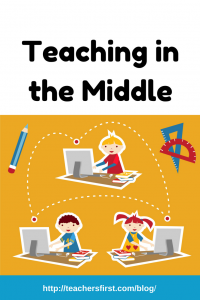 They say that it takes a special person to teach in a middle school and most days during my career as a middle-school educator I would wholeheartedly agree with that sentiment. Here’s why— the brain is said to be fully mature by the age of 25. This leaves a challenge for all K-12 educators, but during adolescence in particular, the challenge is heightened. The middle school brain is filled with emotion and changes… so how could we possibly guess as to the best way to consistently engage these students in the classroom?! One of my former bosses once told a story about a middle school student who brought a raw egg (yes, an egg!) into school one day. You could probably guess this didn’t end well; the egg proceeded to drop out of his sweatshirt pocket during class and suffice it to say, his teacher was not thrilled. After a trip to the office, it was determined that he had no clue as to why the egg was in his pocket. A seemingly well-behaved, academically successful student who just made a “middle school” decision. This story about sums it up… you never know what you’re going to get in “the middle”.
They say that it takes a special person to teach in a middle school and most days during my career as a middle-school educator I would wholeheartedly agree with that sentiment. Here’s why— the brain is said to be fully mature by the age of 25. This leaves a challenge for all K-12 educators, but during adolescence in particular, the challenge is heightened. The middle school brain is filled with emotion and changes… so how could we possibly guess as to the best way to consistently engage these students in the classroom?! One of my former bosses once told a story about a middle school student who brought a raw egg (yes, an egg!) into school one day. You could probably guess this didn’t end well; the egg proceeded to drop out of his sweatshirt pocket during class and suffice it to say, his teacher was not thrilled. After a trip to the office, it was determined that he had no clue as to why the egg was in his pocket. A seemingly well-behaved, academically successful student who just made a “middle school” decision. This story about sums it up… you never know what you’re going to get in “the middle”.
Now, how could we, as educators, possibly engage these students? Here are some general ideas on how to engage them in 21st century learning experiences:
Create an inviting learning environment.
One where students feel supported, one where risk-taking is encouraged, and one where students are offered opportunities to share their feelings and have a voice.
Provide clear instructions and expectations.
Structure and planning is essential. Emphasize instructions both verbally and in writing, if possible. Provide scaffolding and slowly encourage more academic independence and choice for your lesson planning.
Model.
Model both desired behaviors and student outcomes. Of course, don’t forget to recognize and positively reinforce students when outcomes are met. Continue this all… school-year… long.
Check for understanding.
Don’t neglect this step as formative assessment is key to gauging comprehension and planning instruction moving forward. This could be a simple, informal check such as a think-pair-share, or a more structured check as a written exit ticket.
Feedback, feedback, feedback.
Be active in the learning process and look to diversify ways in which you provide feedback.
Be patient.
Easier said than done, I know! Especially if you’re in the middle of an important lesson and a student drops a raw egg, as referenced in my story above. Remember that your students are going through explainable changes and experiences and sometimes their actions just don’t make sense. Talk to them, create connections, and stay calm (and forgive yourself when you don’t!).
As a middle-level educator, it is your responsibility to help shape the brains of our developing students. The tools and skills you provide will empower them to maximize their potential now and prepare them for their future opportunities in the 21st century.

